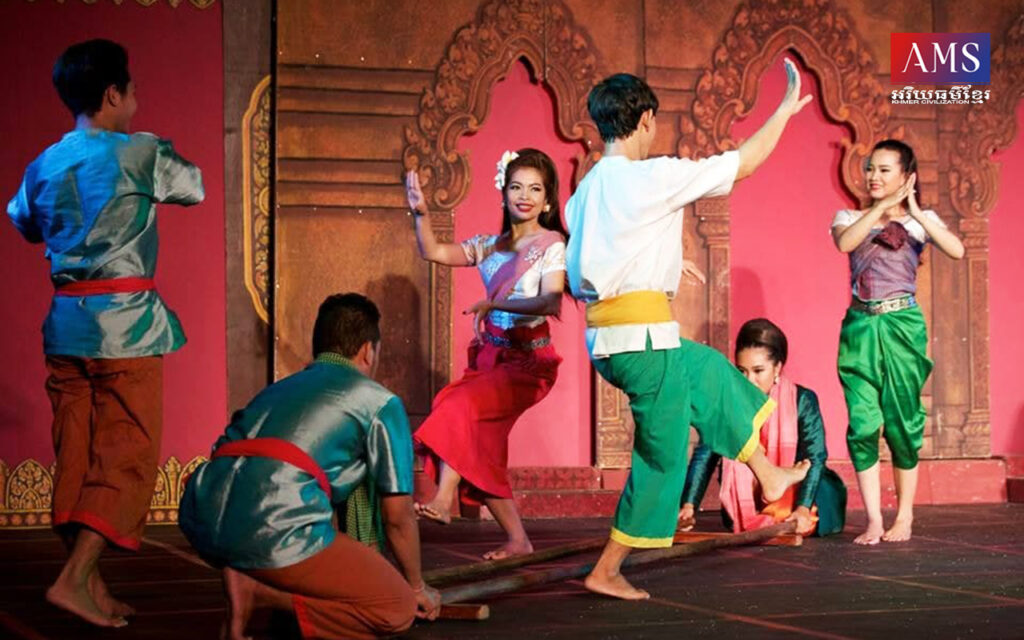កសិកម្មជាមូលដ្ឋានដ៏សំខាន់មួយនៅក្នុងបណ្តាប្រទេស មានកម្ពុជា ថៃឡង់ដ៍ ឡាវ ឥណ្ឌូណេស៊ី និងហ្វ៊ីលីព្ពីន។ល។ ដូច្នេះ កសិកម្ម នៅក្នុងទម្រង់ផ្សេងៗគ្នា ត្រូវបានគេយកជាមូលដ្ឋានដើម្បីបង្កើតនិងអភិវឌ្ឍស្នាដៃសិល្បៈជាដើមនៅក្នុងបណ្តាប្រទេសខាងលើនេះ។
នៅកម្ពុជា គេប្រើអង្រែនិងត្បាល់តាមបែបបុរាណដើម្បីនឹងបុកស្រូវយកអង្ករ។ អ្នកបុកពីរនាក់ ម្នាក់ដៃម្ខាងកាន់អង្រែ បុកឆ្លាស់គ្នាទៅក្នុងត្បាល់ជាចង្វាក់ ជាមូលដ្ឋានដែល សិល្បករយើងយកមកច្នៃប្រឌិតបង្កើតជារបាំអង្រែនេះឡើង។ របាំអង្រែ មានឈ្មោះផ្សេងៗ គ្នាដែលគេធ្លាប់ហៅ មានរបាំអង្រែ របាំគោះអង្រែ ឬរបាំរាំអង្រែ។
ក្រុមជំនុំទំនៀមទម្លាប់ខ្មែរ បានអះអាងថានាសម័យមុន របាំអង្រែមានប្រជាប្រិយភាពនិងមានគេសម្តែងនៅទូទាំងប្រទេសកម្ពុជា។ របាំអង្រែនេះអាចមានប្រភពដើមពីជនជាតិដើមគួយនៃកម្ពុជា (ដែលគេហៅរបាំនេះថា «របាំគួយ») និងជនជាតិហ្វ៊ីលីព្ពីនដែលបានសម្តែងថ្វាយព្រះបាទសម្តេចព្រះសុវណ្ណកោដ្ឋនៅពេលដែលព្រះអង្គទ្រង់បានយាងធ្វើព្រះរាជទស្សនកិច្ចនៅទីក្រុងម៉ានីល។ នាពេលនោះ នាដការីរបាំព្រះរាជទ្រព្យដែលអមព្រះរាជ ដំណើរព្រះអង្គ អាចបានរៀនរបាំអង្រែពីហ្វ៊ីលីព្ពីន។
នៅមុនសម័យសង្គ្រាមឆ្នាំ១៩៧៥ គេឃើញមានរបាំនេះសម្តែងតែនៅក្នុងតំបន់មួយចំនួន ដូចជាសម្រោងចុងកាល់និងជាំក្សាន្តផ្នែកខាងពាយ័ព្យនៃប្រទេសកម្ពុជា។ ក្រុមជំនុំទំនៀមទម្លាប់ខ្មែរ ក៏បានអះអាងដែរថា ការសម្តែងរបាំអង្រែនៅសម្រោងចុងកាល់និង ជាំក្សាន្ត មានយថាភាពជាងនៅកន្លែងឯទៀត ទាំងចលនា ក្បាច់ សម្លៀកបំពាក់ តន្ត្រី និងចម្រៀង។

វង់តន្ត្រីដើមដែលគេប្រើសម្រាប់កំដររបាំអង្រែ មានឧបករណ៍ខ្សែមួយ១ និងអង្កួច១ អមដោយសូរនិងចង្វាក់នៃអង្រែដែលគេគោះទៅលើកំណល់នៅលើដី។ ទៅតាមការនិយម និងចំណង់ចំណូលចិត្តនៃក្រុមនីមួយៗ ក្រុមខ្លះមានបន្ថែមស្គរដៃ១និងក្រាប់១គូឬច្រើនគូ ថែមទៀតផង។
របាំអង្រែបច្ចុប្បន្នដែលយើងឃើញសព្វថ្ងៃ ជាស្នាដៃបង្កើតឡើងដោយសិល្បករ សិល្បការិនីនៃសាកលវិទ្យាល័យភូមិន្ទវិចិត្រសិល្បៈ ដែលមានលក្ខណៈផ្សេងពីរបាំរាំអង្រែ ដើម មានតែការប្រើប្រាស់អង្រែជាឧបករណ៍មួយប៉ុណ្ណោះដែលដូចគ្នា។ ចំពោះស្ថានភាព ផ្សេងទៀត ដូចជាបរិបទ ប្រធានបទ ចលនា ក្បាច់ សម្លៀកបំពាក់ តន្ត្រី និងចម្រៀង ត្រូវបានគេបង្កើតថ្មីទាំងអស់។ ហើយរបាំអង្រែបច្ចុប្បន្ន កំដរដោយវង់តន្ត្រីមហោរីវិញ។
ក្នុងរបាំ គេយកអង្រែមួយគូៗទៅដាក់នៅលើកំណល់ឈើមួយនៅខាងចុងសងខាង រួចអ្នកគោះត្រូវគោះទៅលើកំណល់ជាចង្វាក់តាមភ្លេង។ អ្នករាំជាគូៗ ស្រីមួយ ប្រុសមួយ រាំដោយបោះជើងទៅក្នុងចន្លោះអង្រែនិងទៅក្រៅអង្រែ ព្រមទាំងទះដៃទៅតាមចង្វាក់ភ្លេង និងជួនកាលក៏ច្រៀងជាមួយផង។ នៅចុងរបាំ ភ្លេងក៏ចាប់លេងរន្ថើនលឿនឡើងៗ រួចហើយបញ្ចប់របាំភ្លាម។

—————————————–
Pestle Dance
Agriculture is a fundamental necessity for the agrarian society of many countries, namely, Cambodia, Thailand, Laos, Indonesia, and the Philippines. Thus there is no doubt that “agriculture,” under diverse forms, is depicted in the various regions of these countries.
Pestles and mortars are used in Cambodia as an old-fashioned, traditional way of milling rice paddies. Usually two persons, each with a pestle in hand, pound alternately in a constant rhythm, an action which provides the basis for the dance.
Robaim Angre or Pestle Dance is known under several names: Robaim Kuoh Angre (Chap 1964: 54, 67) and Robaim Roam Angre (ibid: 54, 63). According to the Commission des Moeurs et Coutumes du Cambodge, in the olden days, the Pestle Dance was popularly and widely performed all over Cambodia. The Pestle Dance owes its origin to two possible groups: the Kuoy in Cambodia (ibid.: 63) and the Filipinos who entertained Preah Bat Samdech Preah Sovannakaod during his trip to Manila, where his dancers might have learned the dance
Prior to the war-time of the mid-1970s, the dance was confined to a few places like Samraong Changkal and Choam ksan regions in the northwestern part of Cambodia. The Commission des Moeurs et Coutumes du Cambodge claimed that the dance which was performed in Samraong Chongkal and Choam Ksan was much more authentic than that which was performed elsewhere—in movements, costumes, music, and songs.
The original music ensemble included one khsae muoy (monochord) and one ankuoch (jaw’s harp) accompanied by the sounds and rhythms of the pestles. Depending upon individual taste, a given group may also include one skor dai (goblet drum), and one or several pairs of krapp (clappers).
The dance in the present form is the creation of the Royal University of Fine Arts. It bears dissimilarities to the old forms. Only the pestles can be said to be a derivative of the old. Other aspects, such as performance context, theme, music, lyrics, movements, gestures, and costumes are all anew. Today, the original ensembles have been replaced by a mohori ensemble.
In the dance, pestles are aligned on cross-bars, one at each end, and hit in synchronized rhythms by two persons. Couples of male and female dancers dance between the pestles in perfect synchronization while clapping hands and, sometimes, singing. As the dance progresses, the rhythms accelerate to a climax and then ends abruptly. Finally a coda, in a slow tempo, sets in and brings the dance to its close.
អត្ថបទដោយ៖ បណ្ឌិត សំ សំអាង






